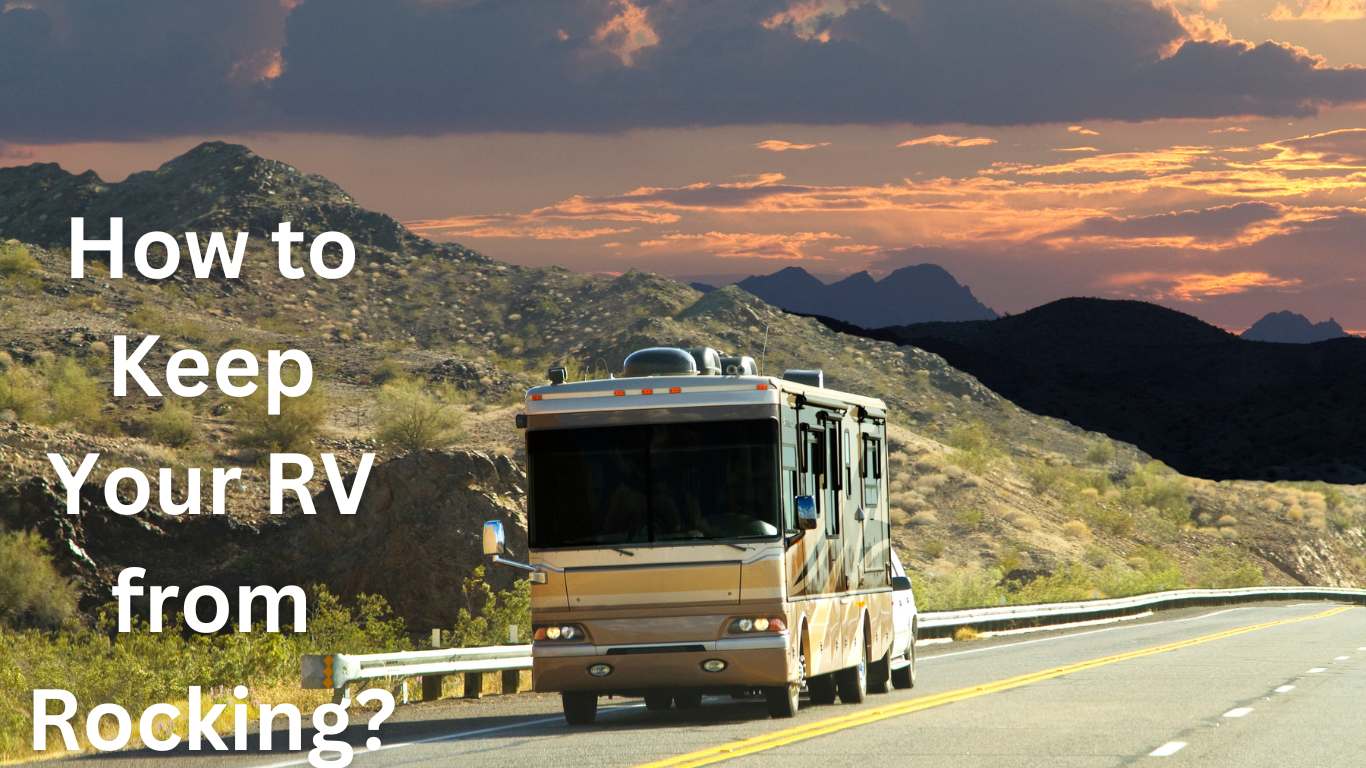When you’re parked at a campsite, keeping your RV from rocking is crucial for a comfortable and stable experience. Whether you’re in a motorhome, travel trailer, fifth-wheel camper, or camper trailer, these practical steps can help minimize unwanted movement.
Why Does Your RV Rock?
Understanding the causes of RV rocking is the first step to solving it.
- Unbalanced Weight Distribution
Improperly loaded RVs can cause instability. - Soft Suspension
RV suspensions are designed for travel, which can lead to movement when stationary. - Uneven Ground
Parking on uneven surfaces can amplify rocking.
Factors That Force You to Keep Your RV from Rocking
Unwanted rocking in an RV can disrupt your comfort and even affect the durability of your vehicle. Understanding the causes behind RV rocking is essential to address the problem effectively. Let’s explore the factors that force you to stabilize your RV.
1. Uneven Parking Surfaces
Parking on sloped or uneven terrain causes imbalance, making your RV prone to rocking. Campgrounds with soft soil or gravel can amplify this issue.
2. Weight Distribution Imbalance
An unevenly loaded RV leads to unnecessary swaying. Overloaded sections, particularly at the rear or sides, destabilize the vehicle.
3. Movement Inside the RV
Activities like walking, cooking, or even rolling over in bed can cause noticeable rocking, especially in RVs without proper stabilization systems.
4. High Winds and External Forces
Strong winds or passing vehicles can shake your parked RV, forcing you to secure it against these external forces.
5. Suspension Design
RV suspensions are built for mobility, not stationary stability. This makes the vehicle more likely to move when parked, especially in lightweight travel trailers or camper trailers.
6. Lack of Stabilization Equipment
Without stabilizers, chocks, or leveling blocks, your RV has minimal resistance to rocking caused by internal or external factors.
Methods to Keep Your RV from Rocking
Ensuring your RV stays stable while parked is essential for a comfortable and safe experience. Here are the best methods to keep your RV from rocking, whether you own a motorhome, fifth-wheel camper, travel trailer, or camper trailer.
1. Use RV Stabilizers
Stabilizers are a must-have to minimize rocking. They support your RV and prevent unwanted movement.
- Scissor Jacks: Budget-friendly and versatile for various RV types.
- Tripod Stabilizers: Perfect for fifth-wheel campers to stabilize the front.
- Permanent Stabilizer Systems: High-tech options for effortless leveling and stabilization.
2. Install Wheel Chocks
Wheel chocks are essential for reducing side-to-side movement. Place heavy-duty rubber or metal chocks tightly against your RV’s tires for the best results.
3. Level Your RV with Blocks
When parked on uneven ground, leveling blocks are crucial. They create a flat foundation for your RV, reducing rocking and ensuring your stabilizers perform better.
4. Balance the Load
An unbalanced RV is more likely to rock. Distribute weight evenly throughout the vehicle to prevent excessive sway or shifting.
5. Secure Items Inside the RV
Loose items can shift during movement, amplifying the rocking sensation. Use storage solutions and secure heavy objects to minimize interior disturbances.
6. Use X-Chocks for Added Stability
X-chocks fit between tandem wheels and provide extra stability by locking the tires in place. They’re particularly useful for travel trailers.
7. Choose a Stable Parking Spot
Select a campsite with firm, level ground. Avoid soft soil or sloped areas that can worsen rocking.
Essential Tools to Keep Your RV from Rocking
Keeping your RV stable while parked is crucial for comfort and safety. Having the right tools can make all the difference in preventing unwanted rocking. Here are the essential tools every RV owner should have to enjoy a stable camping experience.
1. RV Stabilizer Jacks
Stabilizer jacks are the backbone of RV stability. They provide support to reduce both front-to-back and side-to-side movement.
- Scissor Jacks: Affordable and easy to adjust for most RVs.
- Hydraulic Stabilizers: A high-tech option for effortless and precise stabilization.
2. Wheel Chocks
Wheel chocks prevent tire movement, which is often a primary cause of rocking. They come in various materials to suit different RV setups.
- Rubber Chocks: Durable and provide excellent grip.
- Heavy-Duty Metal Chocks: Ideal for larger motorhomes or fifth wheels.
3. X-Chocks for Dual-Axle RVs
X-chocks are designed to fit between tandem wheels, locking them in place to prevent rocking caused by tire shift.
4. Leveling Blocks
Leveling blocks ensure your RV is parked on an even surface. They work well on sloped or uneven terrain and help stabilizers function effectively.
5. Tripod Stabilizers (for Fifth-Wheels)
For fifth-wheel campers, a tripod stabilizer provides added front-end stability, reducing rocking during movement inside the RV.
6. Automatic Leveling Systems
An automatic leveling system is a high-end solution that levels and stabilizes your RV with minimal effort, offering maximum comfort.
Steps to Keep Your RV from Rocking
Stabilizing your RV is essential for a comfortable and secure camping experience. Follow these straightforward steps to prevent rocking and ensure your RV stays steady, whether it’s a motorhome, fifth-wheel camper, or travel trailer.
Step 1: Park on Level Ground
Choose a flat and stable parking spot. Avoid uneven surfaces or soft soil, as they can cause imbalance. If necessary, use leveling blocks to compensate for sloped ground.
Step 2: Chock Your Wheels
Place heavy-duty wheel chocks securely against your tires to prevent any forward or backward movement. For added stability, use X-chocks between tandem wheels on dual-axle RVs.
Step 3: Deploy Stabilizer Jacks
Lower stabilizer jacks at all four corners of your RV. Ensure they are firmly in contact with the ground but avoid over-tightening, which can damage the jacks or your RV frame.
Step 4: Use a Tripod Stabilizer (for Fifth-Wheels)
If you own a fifth-wheel camper, set up a tripod stabilizer under the front hitch. This reduces front-end rocking caused by movement inside the RV.
Step 5: Balance the Weight
Distribute the weight inside your RV evenly to maintain balance. Avoid overloading one side, which can lead to swaying or tipping.
Step 6: Secure Loose Items Inside
Anchor down heavy or loose items inside your RV to minimize movement caused by shifting objects. This step also protects your belongings during travel.
Step 7: Double-Check Stability
Once all tools are in place, test your RV for movement by walking inside. If there’s still rocking, adjust the jacks or reposition the chocks until it feels stable.
Do You Need a Professional to Keep Your RV from Rocking, or Can You Do It Yourself?
Keeping your RV from rocking is essential for comfort and safety during your travels. The big question is: should you hire a professional, or can you handle it yourself? Let’s explore both options to help you decide.
DIY: Keeping Your RV Stable on Your Own
With the right tools and knowledge, you can easily stabilize your RV without professional help.
Advantages of Doing It Yourself:
- Cost Savings
DIY eliminates labor costs associated with professional services. - Ease of Access to Tools
Tools like stabilizer jacks, wheel chocks, and leveling blocks are affordable and widely available. - Flexibility
You can address rocking issues immediately, without waiting for a professional.
Tools You’ll Need for DIY Stability:
- Stabilizer jacks (manual or hydraulic)
- Wheel chocks or X-chocks
- Leveling blocks
- Tripod stabilizers (for fifth-wheel RVs)
Steps to DIY Stabilization:
- Park on a level surface and deploy stabilizer jacks.
- Use wheel chocks to prevent tire movement.
- Balance the load inside your RV and secure loose items.
When to Call a Professional
While most RV rocking issues can be resolved on your own, there are scenarios where professional help is recommended.
Situations Requiring a Professional:
- Complex Suspension Adjustments
If your RV’s suspension is causing instability, a professional may need to inspect or modify it. - Damaged Stabilization Equipment
Broken jacks or leveling systems should be repaired by a trained technician. - Advanced Systems Installation
Installing automatic leveling systems or permanent stabilizers often requires expert knowledge.
Advantages of Hiring a Professional:
- Ensures proper installation and repairs.
- Saves time if you’re unfamiliar with RV systems.
- Reduces the risk of accidental damage.
Common Mistakes When Keeping an RV from Rocking and Their Solutions
Stabilizing your RV is essential for comfort, but mistakes can lead to ongoing rocking issues. Here are the most common errors RV owners make and the solutions to keep your vehicle steady.
Mistake 1: Parking on Uneven Ground
Parking on sloped or uneven surfaces makes stabilization challenging and increases rocking.
Solution:
Always park on level ground whenever possible. If the terrain is uneven, use leveling blocks to create a flat foundation before deploying stabilizers.
Mistake 2: Over-Relying on Stabilizer Jacks
Stabilizer jacks are designed to reduce movement but not to support the entire weight of the RV. Misusing them can lead to damage or insufficient stability.
Solution:
Use stabilizer jacks only for their intended purpose. Pair them with wheel chocks and leveling blocks for maximum stability.
Mistake 3: Failing to Use Wheel Chocks
Skipping wheel chocks leaves your RV vulnerable to rolling or shifting, which causes rocking.
Solution:
Always place sturdy wheel chocks against the tires, even on flat ground. For dual-axle RVs, use X-chocks for added security.
Mistake 4: Uneven Weight Distribution
An unbalanced load inside the RV can cause it to sway, especially during movement inside the vehicle.
Solution:
Distribute weight evenly across the RV. Keep heavy items centered and secure them to prevent shifting.
Mistake 5: Ignoring Loose Interior Items
Unsecured items inside the RV can amplify the rocking sensation when they move.
Solution:
Secure all loose items using straps or storage bins. Keep heavy objects on the floor and close to the RV’s center.
Mistake 6: Not Checking Stabilization Tools Regularly
Using worn-out or improperly adjusted tools can compromise your RV’s stability.
Solution:
Inspect your stabilizers, wheel chocks, and leveling blocks regularly for damage or wear. Replace or adjust them as needed to ensure proper functionality.
Safety Precautions to Keep Your RV from Rocking
Stabilizing your RV is not just about comfort—it’s also a matter of safety. Unwanted rocking can lead to accidents, damage, or even injury. Follow these essential safety precautions to ensure your RV remains steady and secure.
1. Park on Stable and Level Ground
Parking on uneven or unstable surfaces can increase rocking and reduce the effectiveness of stabilizers.
Precaution:
- Choose firm and level terrain whenever possible.
- Use leveling blocks to compensate for uneven ground.
2. Use Wheel Chocks Properly
Wheel chocks are crucial to prevent the RV from rolling or shifting while parked.
Precaution:
- Place wheel chocks firmly against the tires on both sides.
- For dual-axle RVs, use X-chocks for additional stability.
3. Avoid Overloading the Stabilizers
Stabilizer jacks are meant to reduce rocking, not bear the full weight of your RV.
Precaution:
- Lower stabilizers gently until they contact the ground.
- Never use them to lift or level your RV.
4. Distribute Weight Evenly
Uneven weight distribution can cause your RV to sway or tip, leading to instability.
Precaution:
- Keep heavy items centered and evenly distributed.
- Secure all loose items inside the RV to prevent shifting during use.
5. Inspect Equipment Regularly
Worn or damaged stabilizers, chocks, or leveling blocks can compromise your RV’s stability.
Precaution:
- Check all stabilization tools for signs of wear or damage before each trip.
- Replace faulty equipment immediately.
6. Secure the RV Before Moving Inside
Activities like walking or moving inside the RV can exacerbate rocking if the vehicle isn’t properly secured.
Precaution:
- Ensure all stabilizers and chocks are in place before entering or moving inside the RV.
- Avoid excessive movement if the RV isn’t fully stabilized.
7. Avoid Parking in High-Wind Areas
Strong winds can cause your RV to sway, even when stabilized.
Precaution:
- Park in sheltered locations whenever possible.
- Use additional stabilizers if parking in windy conditions is unavoidable.
More related details will be available on Flamingo Motorhomes.

